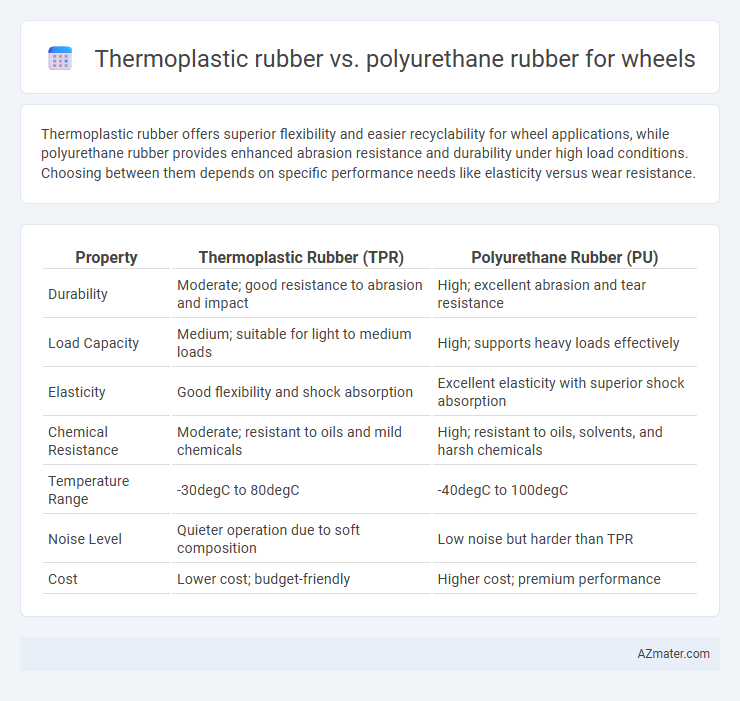Thermoplastic rubber offers superior flexibility and easier recyclability for wheel applications, while polyurethane rubber provides enhanced abrasion resistance and durability under high load conditions. Choosing between them depends on specific performance needs like elasticity versus wear resistance.
Table of Comparison
| Property | Thermoplastic Rubber (TPR) | Polyurethane Rubber (PU) |
|---|---|---|
| Durability | Moderate; good resistance to abrasion and impact | High; excellent abrasion and tear resistance |
| Load Capacity | Medium; suitable for light to medium loads | High; supports heavy loads effectively |
| Elasticity | Good flexibility and shock absorption | Excellent elasticity with superior shock absorption |
| Chemical Resistance | Moderate; resistant to oils and mild chemicals | High; resistant to oils, solvents, and harsh chemicals |
| Temperature Range | -30degC to 80degC | -40degC to 100degC |
| Noise Level | Quieter operation due to soft composition | Low noise but harder than TPR |
| Cost | Lower cost; budget-friendly | Higher cost; premium performance |
Introduction to Thermoplastic Rubber and Polyurethane Rubber
Thermoplastic rubber (TPR) combines the elasticity of rubber with the recyclability of plastics, offering excellent flexibility, chemical resistance, and ease of molding, making it suitable for wheels requiring shock absorption and durability. Polyurethane rubber (PUR) features superior abrasion resistance, load-bearing capacity, and resistance to oils and solvents, providing enhanced performance for wheels exposed to harsh industrial environments. Both materials balance durability and flexibility, but TPR excels in lightweight applications, while polyurethane rubber is preferred for heavy-duty and wear-resistant wheels.
Chemical Composition and Structure Comparison
Thermoplastic rubber (TPR) consists of a dual-phase structure combining hard thermoplastic segments and soft elastomeric segments, allowing reversible physical crosslinking and recyclability, with a chemical composition typically based on styrenic or olefinic blocks. Polyurethane rubber (PUR) is chemically composed of linear or crosslinked polyurea and polyurethane segments formed through the reaction of polyols and diisocyanates, providing superior abrasion resistance and mechanical performance. The molecular architecture of TPR promotes flexibility and processability, while PUR's urethane linkages offer enhanced chemical resistance and load-bearing capabilities, crucial for durable wheel applications.
Manufacturing Processes for Wheel Applications
Thermoplastic rubber (TPR) wheels are typically produced through injection molding, allowing for efficient mass production and easy recyclability due to their thermoplastic nature. Polyurethane rubber wheels are manufactured primarily via reaction injection molding (RIM) or compression molding, enabling superior wear resistance and load-bearing capacity tailored through precise chemical formulations. The choice between TPR and polyurethane affects cycle time, cost-efficiency, and mechanical properties in wheel manufacturing processes for applications such as industrial casters and trolley wheels.
Durability and Wear Resistance
Thermoplastic rubber (TPR) offers excellent flexibility and moderate wear resistance, making it suitable for wheels requiring shock absorption and light to medium-duty usage. Polyurethane rubber (PU) excels in durability and abrasion resistance, providing superior performance in high-load and heavy-duty wheel applications where long service life and resistance to wear are critical. The choice between TPR and PU wheels hinges on balancing cost-effectiveness with enhanced toughness and operational longevity.
Load Bearing Capacity and Flexibility
Thermoplastic rubber (TPR) offers excellent flexibility and moderate load-bearing capacity, making it ideal for applications requiring shock absorption and smooth rolling. Polyurethane rubber (PU) delivers superior load-bearing capacity and abrasion resistance, supporting heavier loads while maintaining durability under stress. Both materials provide valuable performance advantages, but PU wheels excel in industrial settings with high weight demands, whereas TPR wheels are preferred for lighter, more flexible use cases.
Shock Absorption and Vibration Damping
Thermoplastic rubber (TPR) provides excellent shock absorption due to its flexible molecular structure, making it ideal for wheels that need to cushion impacts. Polyurethane rubber excels in vibration damping with higher load-bearing capacity and superior resistance to deformation under stress, allowing wheels to maintain stability on uneven surfaces. Choosing between TPR and polyurethane depends on prioritizing either enhanced impact cushioning or durable vibration isolation for wheel applications.
Environmental Resistance: Temperature, Chemicals, and UV
Thermoplastic rubber (TPR) offers moderate environmental resistance with excellent flexibility across a wide temperature range from -40degC to 120degC but tends to degrade faster under prolonged UV exposure and certain chemicals like oils and solvents. Polyurethane rubber (PU) excels in chemical resistance, maintaining durability against oils, greases, and many solvents while withstanding temperatures from -30degC up to 90degC and showing superior UV stability, making it ideal for outdoor wheel applications. PU's superior abrasion resistance and minimal degradation under environmental stress contribute to longer service life compared to TPR in demanding chemical and UV exposure conditions.
Cost-Effectiveness and Lifespan Analysis
Thermoplastic rubber (TPR) wheels offer cost-effective production with moderate durability, making them suitable for budget-friendly applications requiring flexibility and impact resistance. Polyurethane (PU) rubber wheels provide superior lifespan due to higher abrasion resistance, load-bearing capacity, and chemical stability, justifying higher initial costs in long-term industrial use. Evaluating total cost of ownership reveals polyurethane wheels often deliver better value through reduced replacement frequency and maintenance expenses.
Common Applications in Different Industries
Thermoplastic rubber (TPR) wheels are commonly used in medical devices, consumer goods, and light industrial equipment due to their flexibility, noise reduction, and chemical resistance. Polyurethane (PU) rubber wheels are preferred in heavy-duty industrial applications such as forklifts, material handling, and warehouse automation for their superior load-bearing capacity, abrasion resistance, and durability. Both materials serve distinct roles where TPR is ideal for softer, quieter wheels, while PU excels in high-performance environments requiring toughness and long lifespan.
Choosing the Best Material for Your Wheel Needs
Thermoplastic rubber (TPR) offers excellent flexibility, impact resistance, and ease of recycling, making it ideal for lightweight wheels requiring durability and shock absorption. Polyurethane rubber delivers superior load capacity, abrasion resistance, and chemical resilience, making it the preferred choice for heavy-duty industrial wheels exposed to harsh environments. Evaluating factors such as weight, load, environmental exposure, and cost will determine whether TPR or polyurethane best suits your specific wheel application.

Infographic: Thermoplastic rubber vs Polyurethane rubber for Wheel
 azmater.com
azmater.com